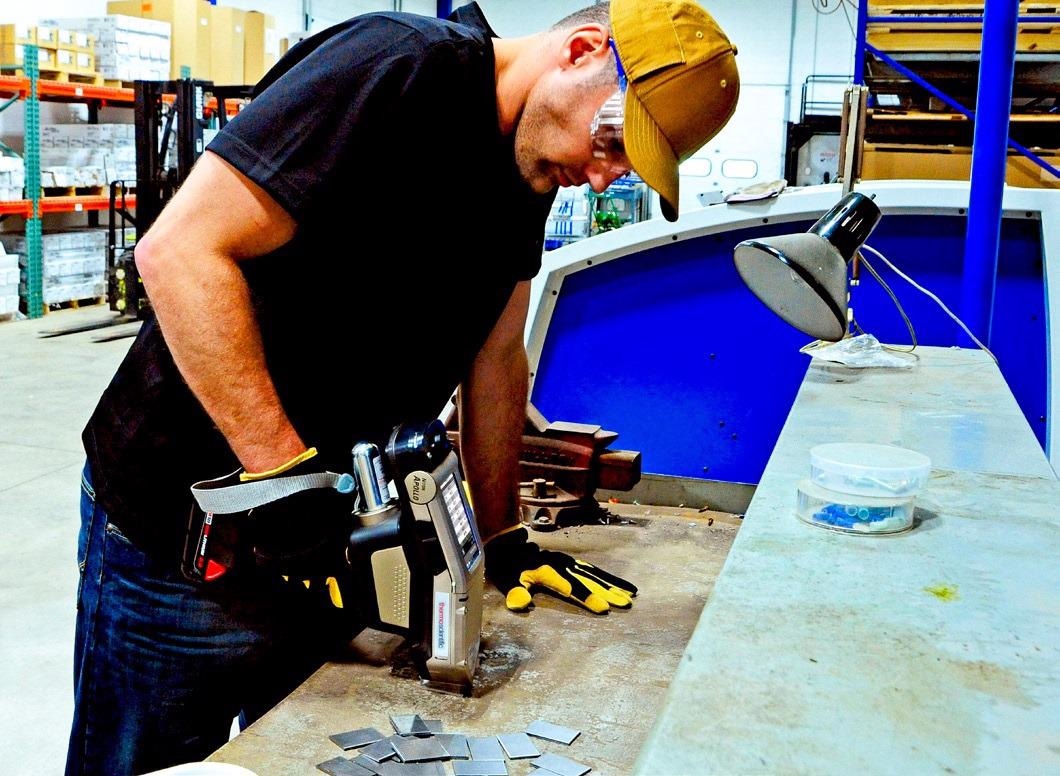Stainless steels are universally used in today’s society. They are produced as tubing, wires, bars, plates, and sheets to be made into every imaginable type of equipment and material. This includes their use in transportation, architecture, food production, power generation, chemical and petrochemical industries, and much more.
With more than 100 distinct grades of stainless steel, which all look similar, one needs to be able to make sure that the appropriate grade is used for the intended purpose.
The Need for Testing
Positive Material Identification (PMI) and Quality Control (QC) instruments have become essential tools for robust material verification programs. These tools help to ensure that the right grade of stainless steel is used in the correct place at the appropriate time.
The incorrect grade can result in consequences as basic as economic loss or as severe as loss of life. Explosions in chemical and petrochemical plants are strong reminders of the hazards involved in using the wrong alloys. Hence, most industries endeavor to ensure satisfactory product quality via the verification of the raw materials used involved in the production process.
Among other material methods of verification, the Mill Test Report (MTR) is sometimes used for the validation of goods. In some cases, the MTR can be incorrect or unreliable due to labeling process mix-ups. It is best practice to carry out a second validation of the MTR to verify goods.

The Niton Apollo in use, validating a Mill Test Report (MTR) prior to fabrication. Image Credit: Thermo Fisher Scientific - Elemental Analyzers and Phase Analyzers
The costly problem of determining goods that have been developed out of specification after adding value during the fabrication process can be avoided by spotting the issue at the start of inspection using elemental analysis. Often, the former can mean the result has to be scrapped entirely.
Material verification does not stop at incoming inspection. QC managers and supervisors must make sure that the right materials are used all the way through the production process. Again, optimum practice necessitates elemental analysis – often for regulatory compliance.
Testing can monitor the part, equipment, or assembly all the way to the last validation before shipping. When the customer receives it, an incoming inspection is usually performed again. It goes on, systematically being inspected along its path to the ultimate use.
Particularly in critical processes, inspection will persist right up until installation. For installations that come before the inspection process (e.g., thirty-year-old refineries), the process may even require an operating refinery to be shut-down in order to test in-process materials that may not have had sufficient testing upon installation.
Challenges of Test Equipment
Both OES (optical emission spectroscopy) and XRF (x-ray fluorescence) have performed material verification in the past. In the early days of testing, the expansive instrumentation necessary for the validation of materials was only found in labs. However, with the miniaturization of lab technologies, in-field and in-process testing is now a reality.
Carbon (C) is an important element for alloying that is added to stainless steel to increase its strength and hardness. To date, carbon analysis has been challenging. Handheld x-ray fluorescence (XRF), the most popular material method of verification, has been incapable of carbon content detection.
Carbon can be detected by Optical Emission Spectroscopy (OES), but this is only available in bulky, large carts, which makes it difficult when applying it too awkward field environments (tight spaces, ditches, catwalks, ladders, etc.).
Carbon content can be between 0.005% to 1.2%, depending on the grade of stainless steel. In some stainless steels, a high carbon content is undesirable, particularly for welding due to the risk of carbide precipitation. Because of these reasons, carbon determination is crucial for safe operation over time and comprehensive verification of grade.
Niton Apollo Handheld LIBS Analyzer
There is now a novel tool available to professionals carrying out material analysis. The Thermo Scientific™ Niton™ Apollo™ handheld LIBS analyzer utilizes Laser Induced Breakdown Spectroscopy (LIBS) to carry out material inspection during the fabrication process.
The Niton Apollo weighs just 6.4 lbs. (2.9 kg.) and specializes in measuring carbon content in a portable, convenient form factor. This eliminates the need for bulky Optical Emission Spectroscopy (OES) carts in many situations.
Featuring a high purity argon purge and effective laser, the Niton Apollo can eliminate risks associated with welding incompatible alloys, replace or confirm inaccurate MTRs, and even differentiate between grades of similar alloys.

Image Credit: Thermo Fisher Scientific - Elemental Analyzers and Phase Analyzers
The Niton Apollo is designed to provide superior results and can measure low levels of carbon in L grade stainless steel of around 100-300 ppm (parts per million). This sensitivity allows the Niton Apollo to differentiate the levels of carbon in 304L with ~300 ppm or ~0.03% carbon, from the ~0.06% level in a 304 grade (for example).
Other cases of the need to test for carbon include 317 vs. 317L and 316 vs. 316L / 316H. Not long ago, only bulky, large OES analyzers were able to quantify low levels of carbon in stainless steel in the field.
Conclusion
The Niton Apollo handheld LIBS analyzer can be utilized for the determination of carbon concentration for quality control (QC) in the fabrication industry. The handheld form allows users to safely and easily carry out material verification directly in the field with lab-quality results and precision.
The main benefit of this advanced design comes from its superior long-term stability, repeatability, and accuracy, making the Niton Apollo an essential tool for the material verification of stainless steel.
Acknowledgment
Produced from materials originally authored by Jim Pasmore from Thermo Fisher Scientific.

This information has been sourced, reviewed and adapted from materials provided by Thermo Fisher Scientific – Handheld Elemental & Radiation Detection.
For more information on this source, please visit Thermo Fisher Scientific – Handheld Elemental & Radiation Detection